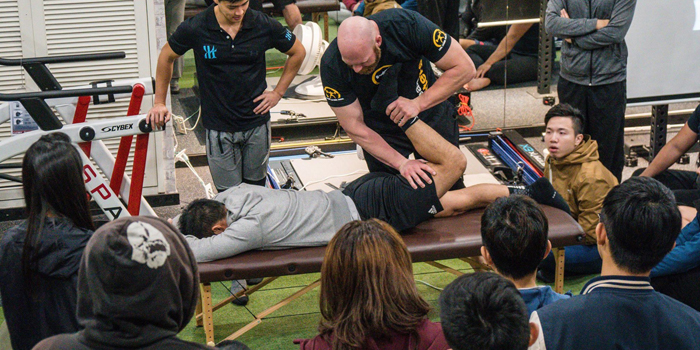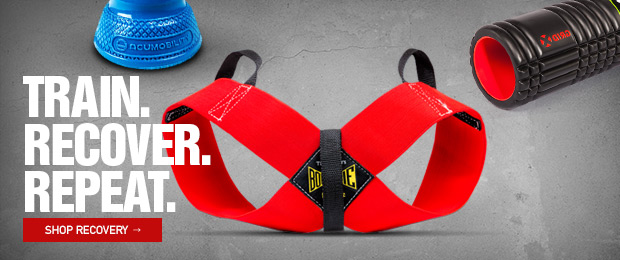
I think the biggest thing is to have someone that looks at you from a complete standpoint as opposed to just a shoulder injury.
I was at the World Championships Juniors and Masters and Women. They held it in Hamilton, just outside of Toronto, back in the ‘90s. They had a Russian lifter, and he was in the 165s, and he was going for a world record, a junior world record. I think it was about 425.
He missed his first attempt, so he came back with the coach and said, “Can you work on him?”
The right arm, he couldn’t lock it properly, so I did some work, did some work on his shoulder and everything.
Then he went for his second attempt, and he also missed that. But what I did notice was that he walked with a limp.
I went, “What happened?”
He says, “Oh, three or four weeks ago, I sprained my right ankle.”
I went, “Alright, so when you’re benching, and you’re pressing hard, is it painful?”
He says, “Oh, yeah, it’s really painful.”
I said, “OK.”
Basically, the shoulder had healed, and I just went down to the ankle and did a ton of work down there. Muscle work, adjusting the ankle, everything else, and he said, “That feels a lot better.”
Basically it was just jammed up from the sprain. I said, “Try pressing down. Is it painful?”
“No.” So he went out, and he actually set the world record.
You need to have someone that will look at you from a complete standpoint, not just, you know, look at the shoulder.
When people come in to see me, I don’t care what you have. I’m going to have you just walk down the hallway. I want to see how you move in motion.
When I had my other clinic, I would put you on a squat. If he says, “It bothers me when I squat,” OK, let’s see how you squat.
A lot of the problems won’t show up until it’s heavier, and that’s the biggest thing is that all of a sudden, all of the deficits start to show up. The arm starts to lag, you start to torque, your body changes as you’re doing deadlifts...
From that, you can actually go, “OK, where is it actually breaking down?” That’s the major issue. It may have nothing to do with the injury — it’s a contributing aspect of it, and that’s what the reoccurrence is.
As far as finding someone, No. 1 is definitely multi-modal. I don’t care if it’s a physical therapist, a chiropractor, most medical doctors — some of them are getting into manual medicine. Most of them, their modalities are usually drugs, and the other aspect that’s coming around is the PRP and the stem cell, which is fantastic. It can really make a big difference in certain situations.
I’m starting to see that (a blend of traditional and holistic medicines fields) more and more, where we’re starting to collectively work together, and that works out the best. You have someone that does manual medicine — your hands are on them, you’re actually working the tissues and everything else. Then you have someone overseeing, like imaging.
Imaging can give you an idea as far as the ultrasound, the X-ray, the MRI, and that gives you an idea of “How bad is it?”
The other flipside is you may have a disc herniation that’s not even contributing to it. It’s already healed.
It was interesting, at SWIS 2016, Donny Thompson, he was showing up, he was putting up all these different X-rays of pre- and post-, and the disc herniation was gone. He pulled these out of some of the orthopedic surgeons he was working with, and went, “Oh, shit! I didn’t know that could happen.”
Donny’s like, “Yeah, it can happen. It can heal. It’s a tissue, it can heal.”
I think the biggest thing is that we tend to underestimate how well the body can heal itself, especially if you go from that, and also, give it time to recover! I think that’s the biggest that I’ve seen, especially as you get older.
I’ve been competing in powerlifting for about 40 years now, and I’ve just seen a huge shift over the years of people just not being patient. They don’t want to put the two to five to ten years in. They want to set records in a year. In bodybuilding: “I want to become an IBB Pro in a year!” So they take a ton of drugs, training, and like everything else, it takes time.
That’s the challenge that most people have. They keep pushing, keep pushing, and they don’t realize you actually heal and actually get stronger when you rest.
Adapted from Table Talk Podcast #9 with Dr. Ken Kinakin
Dr. Ken Kinakin, DC, CSCS, is a sports medicine doctor, chiropractor, certified strength and conditioning specialist, and personal trainer. He’s also the author of the book Optimal Muscle Training and has competed in bodybuilding and powerlifting for over 20 years. Dr. Kinakin lectures around the world to doctors and personal trainers on the areas of weight-training, rehabilitation, and nutrition. He is also the clinic director for the AIM Health & Wellness clinic, with a rehabilitation and training center in Mississauga, Ontario. Dr. Kinakin founded the Society of Weight-Training Injury Specialists (SWIS), an organization that educates and certifies doctors, therapists and personal trainers in the area of exercise muscle testing, rehabilitation, and treatment of weight training injuries.









